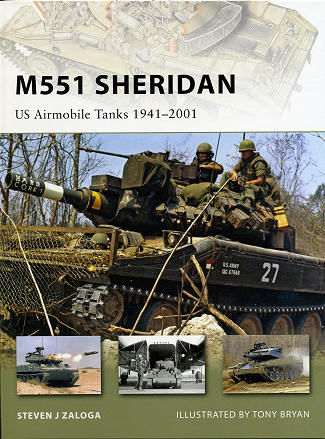 One of the
weaknesses of airborne and air mobile forces has been its general vulnerability
to enemy armor. Although there have been many attempts at providing this sort of
protection by attaching airframes to light tanks or developing large gliders,
none of these were really effective nor put into use. The real key was to have a
tank that would fit into the new heavy haul transports that were being developed
just after WWII. Aircraft like the C-82/C119 which had aft ramps through which
parachute laden light tanks could be air dropped. These tanks would also be set
upon a collapsible aluminum pallet to help absorb the shock of impact with the
ground. Naturally, these tanks would be unmanned at the time.
One of the
weaknesses of airborne and air mobile forces has been its general vulnerability
to enemy armor. Although there have been many attempts at providing this sort of
protection by attaching airframes to light tanks or developing large gliders,
none of these were really effective nor put into use. The real key was to have a
tank that would fit into the new heavy haul transports that were being developed
just after WWII. Aircraft like the C-82/C119 which had aft ramps through which
parachute laden light tanks could be air dropped. These tanks would also be set
upon a collapsible aluminum pallet to help absorb the shock of impact with the
ground. Naturally, these tanks would be unmanned at the time.
The first semi-successful US tank was the M22 Locust. While
none were used by US Army forces, some served with the British Army during the
last part of the war. Next attempt was the T-92, another tank that had promise
but was not selected for production. This led to the M551 Sheridan, the only
tank ever successfully developed for the US Army to be air dropped or sent in
with air mobile forces.
As one might expect, the development of the Sheridan was long
and protracted. There were many problems to be overcome, the main one being what
seems to be a constant 'changing of the minds' of the Army brass as to what the
tank would use for its main armament and other bureaucratic minutiae that often
plagues weapons systems developments. The tank was finally put into battle in
Vietnam where it performed with some success. Its light weight construction did
not bode well for its ability to handle mine blast damage, but it was generally
effective.
Despite its fairly good record in Vietnam, the tank was not
built in large numbers and was quickly pulled out of the inventory of most
active army units. One one or two units continued to operate the tank with some
going to reserve forces and most into storage. Despite this, it did have a
chance to enter into battle near the end of its operational career. One thing
not used until a single instance during Desert Storm was the Sheridan's
Shillelagh missile system, one of the primary reasons of its development.
Author Zaloga does his usual superb job of telling the
fascinating story of this rather unique vehicle and its predecessors. Thanks to
a fine selection of photographs as well as the outstanding illustrations of Tony
Bryan, we get to see how the M551 changed from first development to the end of
its career. Another superb addition to the New Vanguard series and one that I am
sure you will enjoy. Buy with confidence.
April 2009
For more on the complete line of Osprey books,
visit www.ospreypublishing.com. In the US, it is
Osprey Direct at 44-02 23rd St, Suite 219, Long Island City, NY 11101., where you can
get a catalogue of available books.
If you would like your product reviewed fairly and quickly, please contact
me or see other details in the Note to
Contributors.
 One of the
weaknesses of airborne and air mobile forces has been its general vulnerability
to enemy armor. Although there have been many attempts at providing this sort of
protection by attaching airframes to light tanks or developing large gliders,
none of these were really effective nor put into use. The real key was to have a
tank that would fit into the new heavy haul transports that were being developed
just after WWII. Aircraft like the C-82/C119 which had aft ramps through which
parachute laden light tanks could be air dropped. These tanks would also be set
upon a collapsible aluminum pallet to help absorb the shock of impact with the
ground. Naturally, these tanks would be unmanned at the time.
One of the
weaknesses of airborne and air mobile forces has been its general vulnerability
to enemy armor. Although there have been many attempts at providing this sort of
protection by attaching airframes to light tanks or developing large gliders,
none of these were really effective nor put into use. The real key was to have a
tank that would fit into the new heavy haul transports that were being developed
just after WWII. Aircraft like the C-82/C119 which had aft ramps through which
parachute laden light tanks could be air dropped. These tanks would also be set
upon a collapsible aluminum pallet to help absorb the shock of impact with the
ground. Naturally, these tanks would be unmanned at the time.